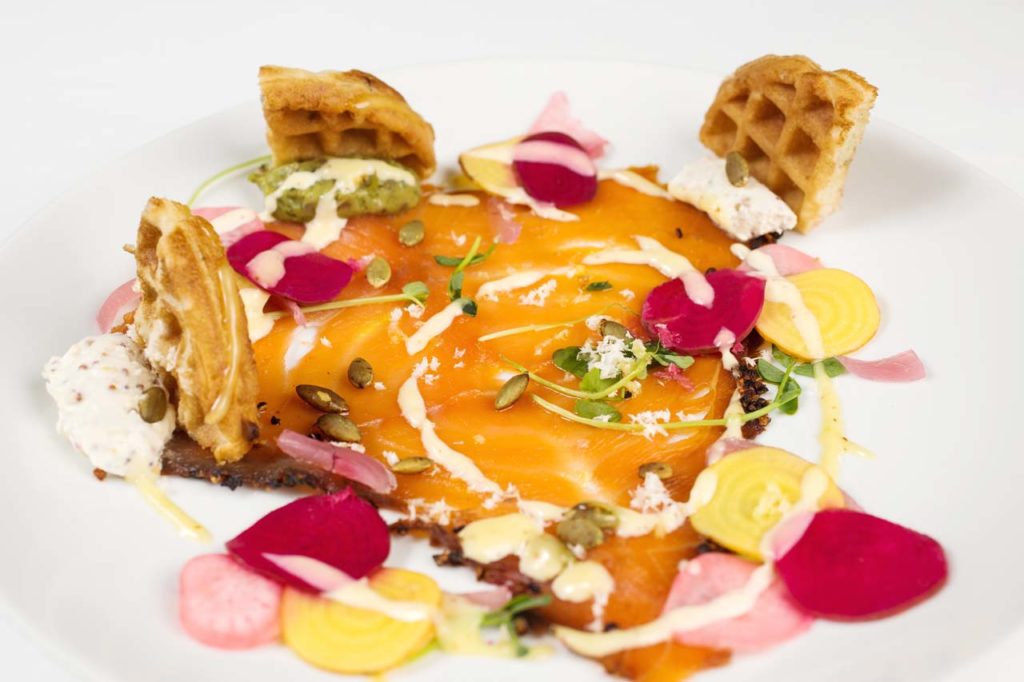AFTER BECOMING A GRAVLAX EXPERT, THIS RIVER CAFÉ VETERAN SOUGHT A NEW WAY TO MAKE CURED SALMON INDELIBLY NEW YORK
BY DAVID BURKE
After graduating from the Culinary Institute of America, I went to work as a personal chef for one of the wealthiest families in Norway. And the job came with a great perk; I got to move to Europe!
Naturally, I brought all my favourite cookbooks, only to learn that one of my hosts’ favourite foods, gravlax, was not represented in any of them. Cured salmon is a mainstay of Norwegians’ diet; like cold cuts in America, there’s always some gravlax in the fridge, and, it seems, always someone cutting a few thin slices and eating them on crisp bread or crackers with a mustard dill sauce. When I found out how easy it was to make, I made gravlax for the family all the time.
It takes about three days to cure salmon. A mixture of salt, freshly-ground white pepper, sugar, and fresh dill is spread on two salmon filets placed together with fresh dill placed under, on top of, and between the filets. The salmon is then placed under something heavy, like an iron fry pan or brick; the pressing removes moisture from the fish, preserving it, even as the mixture adds delicious flavors. (The name gravlax means “buried salmon” in Norwegian, and refers to the practice of preserving foods by burying them.)

Years later, when I became the chef at The River Café, I wanted to make my own “Brooklyn” version of gravlax, and that’s when a terrific idea began to form. I used a lot of salmon in the kitchen at the time, wanted to find a use for the bellies that remained after filleting, and realized that the fatty bellies were perfect for curing. The resulting “Pastrami Salmon,” which I trademarked and which has been copied around the world, is substantially spicier than Scandinavian gravlax, however reminding me of the spice-cured meat of New York delis.
The dish became a hit at the River Cafe, and we experimented with it further. At one point, we took cured salmon, smoked it, and rolled it up in an architect’s tube. The result was a log that looked like cured sausage. Pat Riley, head coach for the New York Knicks at that time, loved it so much that he ordered five logs, and New York magazine called to ask if we would sell them to the public. “Hell, yes!” we replied.
My Pastrami Salmon is available at ACME Smoked Fish (30 Gem Street in Brooklyn) and at Drift house by David Burke in Sea Bright, where it’s served as an appetizer on our menu or as a Sunday brunch dish. I’m hoping to also have it for sale on our website by the winter holidays.
PASTRAMI SALMON
1 cup course salt
½ cup sugar
2 bunches cilantro
1 bunch fresh flat-leaf parsley, well washed
½ pound shallots, peeled and chopped
2 to 2 ½ pounds side salmon, skin and bones removed
½ cup molasses
2 tablespoons cayenne pepper
5 bay leaves
¼ cup paprika
¼ cup ground coriander
¼ cup freshly-ground black pepper
¼ cup cracked black pepper
Combine salt and sugar in a bowl. Place cilantro, parsley, and shallots in bowl of food processor and process to a smooth purée. Place salmon on a platter and generously season both sides with salt-sugar mixture. When well seasoned, coat each side with a generous layer of purée. Cover the platter with plastic wrap.
Place salmon in the refrigerator and allow it to marinate for three days, after which it will be cured. Combine the molasses, cayenne, and bay leaves in a small saucepan over medium heat. Bring to a boil; then lower the heat and simmer for one minute. Remove mixture from the heat and allow to cool. Combine the paprika and the coriander with the black peppers in a small bowl.
Remove salmon from the refrigerator and, using a spatula, scrape off and discard all seasoning from the fish. Using a pastry brush, lightly coat both sides with the cooled molasses mixture. Sprinkle spice mixture on both sides of the salmon to lightly coat it. Place on a clean platter and cover it with plastic wrap. Refrigerate for 24 hours. When you are ready to serve, unwrap and cut, on the bias, into thin slices. Serve with pieces of waffles, blinis, or pancakes.
(Pastrami Salmon will keep, covered and refrigerated, for one week.)
This recipe and many others can be found in David Burke’s New American Classics: Brilliant Variations on Traditional Dishes for Everyday Dining, Entertaining, and Second Day Meals (Alfred A Knopf, 2006).
Drifthouse by David Burke
At the Driftwood Cabana Club, 1485 Ocean Avenue, Sea Bright, 732.530.9760 /
drifthousedb.com
